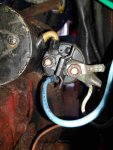Boater Sam
Well-known member
you only need to flash it, reaction will be instant if it is working.
Firstly, if you have a multi meter (or 12v bulb on wire) check if there's voltage with the key turned, to the start terminal on the solenoid. If there is, short out the two large battery connections on the solenoid (an old spanner works) and see if starter motor turns.
you only need to flash it, reaction will be instant if it is working.

Access to the wiring of the starter motor and solenoid very very inaccessible. Just managed to get a picture. Not sure which two wires I should test for power or to short circuit with a spannerView attachment 98305
Yes. Then connect the tag that the blue wire is on as well to the positive.
NO! That would short the battery out if the solenoid was activated, not a good idea!!!!
Positive to the large terminal with 3 connections on, Negative to the engine block, anywhere solid metal, then connect the tag that the blue wire was on to the positive,
I managed to check the ignition switch with a multimeter to the blue wire that bayonets onto the back of the solenoid and am getting the full 12.6v from the battery.
Do let us know what the problem is, hopefully probably something simple.